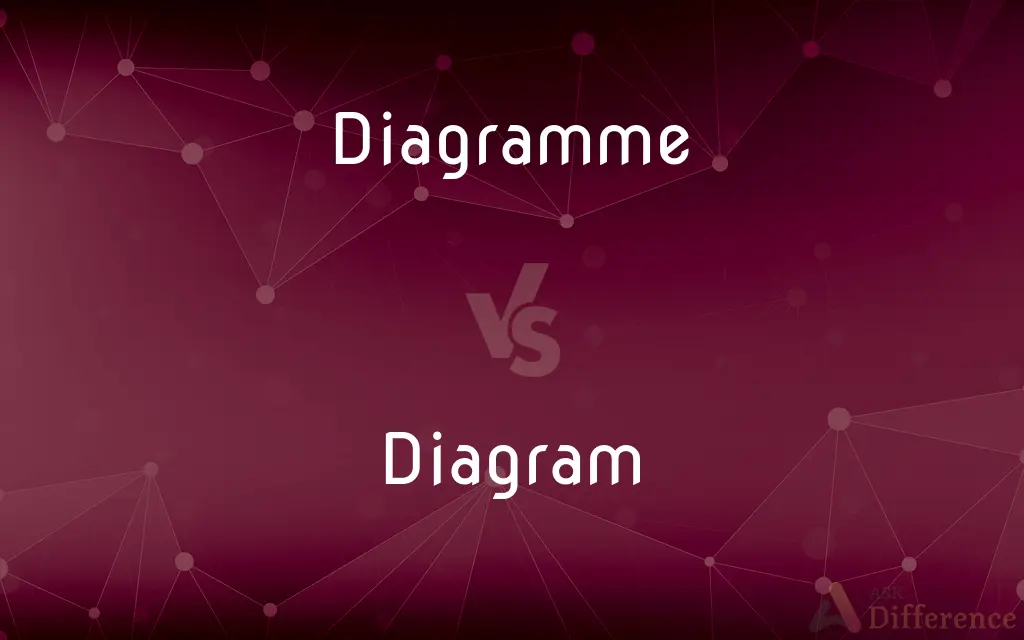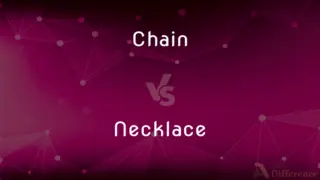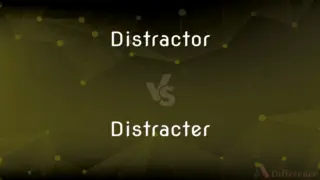Diagramme vs. Diagram — What's the Difference?
By Fiza Rafique & Urooj Arif — Updated on March 6, 2024
Diagramme refers to a chart or graph used to represent information, often seen in French-speaking contexts, while a diagram is a simplified drawing showing the appearance, structure, or workings of something, widely used in English.

Difference Between Diagramme and Diagram
Table of Contents
ADVERTISEMENT
Key Differences
Diagramme is primarily used in French to denote a graphical representation of data or a concept, focusing on visual clarity to convey complex information. It might include charts, graphs, or schematics that illustrate relationships or hierarchies. On the other hand, a diagram in English serves a similar purpose but is more broadly utilized to represent ideas, processes, or systems. It simplifies and visualizes data or concepts to enhance understanding, ranging from technical drawings to flowcharts.
In academic and professional contexts, diagramme might be specific to certain fields like mathematics, physics, or engineering, where precision and standardization of representation are crucial. Diagrams, however, are pervasive across various disciplines, including education, science, business, and technology. They are tools for brainstorming, planning, explaining, or documenting.
The term "diagramme" reflects the influence of language and cultural preferences on the terminology used in different regions. Diagrams, with their wide-ranging applications and recognition, underscore the universal need to distill and communicate complex information visually.
When it comes to creating and interpreting these visual aids, the principles underlying diagrammes and diagrams are fundamentally similar. Both require an understanding of the information being represented and the ability to abstract and encode it visually. However, the conventions and stylistic nuances might differ, influenced by linguistic and disciplinary traditions.
In terms of utility and function, both diagrammes and diagrams aim to make complex information more accessible. Whether it's a flowchart depicting a software algorithm or a schematic illustrating electrical circuits, the goal is to facilitate understanding through simplification and visual representation. The choice between using "diagramme" or "diagram" often boils down to the intended audience and the conventional terminology of the subject matter.
ADVERTISEMENT
Comparison Chart
Definition
A graphic representation used in French contexts to illustrate data or concepts.
A simplified drawing or chart used universally to explain or represent ideas.
Usage
Primarily in French-speaking academic and professional fields.
Widely used in various disciplines and languages, predominantly English.
Types
Includes charts, graphs, and schematics focusing on relationships or hierarchies.
Encompasses a broad range of visual representations, including flowcharts, technical drawings, and schematics.
Purpose
To convey complex information visually with clarity.
To simplify and visualize data or processes for better understanding.
Language Influence
Reflects the linguistic and cultural preferences in terminology.
Demonstrates a universal approach to visual communication across disciplines.
Compare with Definitions
Diagramme
Can be specialized.
The climatic diagramme showed temperature and rainfall patterns over the year.
Diagram
A simplified drawing.
The manual included a diagram to assemble the furniture.
Diagramme
A graphic representation.
The research paper included a complex diagramme to explain the experiment's results.
Diagram
Cross-disciplinary tool.
Diagrams in business presentations help to visualize growth strategies.
Diagramme
Focuses on visual clarity.
The diagramme effectively conveyed the statistical data at a glance.
Diagram
Universally used.
In science class, we used diagrams to understand cell structures.
Diagramme
Used in specific contexts.
In French engineering texts, a diagramme illustrates mechanical processes.
Diagram
Enhances understanding.
A diagram in the book made the historical timelines clear.
Diagramme
Cultural and linguistic preferences.
The French teacher used a diagramme to illustrate sentence structures.
Diagram
Varied applications.
The project proposal featured a diagram to outline the development process.
Diagramme
Archaic form of diagram
Diagram
A diagram is a symbolic representation of information using visualization techniques. Diagrams have been used since ancient times on walls of caves, but became more prevalent during the Enlightenment.
Diagram
A simplified drawing showing the appearance, structure, or workings of something; a schematic representation
A diagram of the living room
Diagram
Represent (something) in graphic form
The experiment is diagrammed on page fourteen
Diagram
A plan, sketch, drawing, or outline designed to demonstrate or explain how something works or to clarify the relationship between the parts of a whole.
Diagram
(Mathematics) A graphic representation of an algebraic or geometric relationship.
Diagram
A chart or graph.
Diagram
To indicate or represent by or as if by a diagram.
Diagram
A plan, drawing, sketch or outline to show how something works, or show the relationships between the parts of a whole.
Electrical diagrams show device interconnections.
Diagram
A graph or chart.
Diagram
(category theory) A functor from an index category to another category. The objects and morphisms of the index category need not have any internal substance, but rather merely outline the connective structure of at least some part of the diagram's codomain. If the index category is J and the codomain is C, then the diagram is said to be "of type J in C".
Diagram
(transitive) To represent or indicate something using a diagram.
Diagram
(UK) To schedule the operations of a locomotive or train according to a diagram.
Diagram
A figure or drawing made to illustrate a statement, or facilitate a demonstration; a plan.
Diagram
Any simple drawing made for mathematical or scientific purposes, or to assist a verbal explanation which refers to it; a mechanical drawing, as distinguished from an artistical one.
Diagram
To put into the form of a diagram.
Diagram
A drawing intended to explain how something works; a drawing showing the relation between the parts
Diagram
Make a schematic or technical drawing of that shows how things work or how they are constructed
Common Curiosities
Are diagrammes only used in French-speaking countries?
While diagrammes are predominantly used in French-speaking contexts, they can be found in international publications where French is used.
Can diagrams be used in scientific research?
Yes, diagrams are widely used in scientific research to visualize experiments, results, and concepts.
How do diagrams help in business?
In business, diagrams are used to visualize strategies, processes, and structures, aiding in planning and communication.
What is a diagramme?
A diagramme is a graphical representation used mainly in French to illustrate data or concepts, often found in academic and professional fields.
Can diagrammes be considered art?
While primarily functional, some diagrammes, especially those with aesthetic considerations, can be seen as a form of art.
How does a diagram differ from a diagramme?
A diagram is a universally used simplified drawing to explain or represent ideas, while a diagramme is more specific to French contexts but serves a similar purpose.
Do diagrammes require specialized software to create?
Creating complex diagrammes may require specialized software, though basic ones can be made with general drawing tools.
How do diagrams aid in problem-solving?
Diagrams can break down problems into manageable parts, making it easier to visualize solutions and relationships.
Can diagrams and diagrammes be used interchangeably?
While they serve similar purposes, the usage depends on the audience and context, with diagrams being more universally recognized.
How important are diagrams in education?
Diagrams are crucial in education for simplifying complex information and enhancing understanding across subjects.
Are there different types of diagrams?
Yes, there are various types of diagrams, including flowcharts, schematic diagrams, and technical drawings.
Is it easier to learn with diagrams?
Many people find visual learning through diagrams more accessible than text-only methods, as they can simplify and clarify concepts.
How have diagrams evolved with technology?
Technology has enabled more complex and interactive diagrams, enhancing their utility and accessibility.
What skills are required to create effective diagrams?
Effective diagram creation requires an understanding of the subject matter, abstraction skills, and visual design knowledge.
Why are diagrams used in manuals and guides?
Diagrams in manuals and guides simplify assembly, usage, and troubleshooting processes, making instructions clearer.
Share Your Discovery

Previous Comparison
Chain vs. Necklace
Next Comparison
Distractor vs. DistracterAuthor Spotlight
Written by
Fiza RafiqueFiza Rafique is a skilled content writer at AskDifference.com, where she meticulously refines and enhances written pieces. Drawing from her vast editorial expertise, Fiza ensures clarity, accuracy, and precision in every article. Passionate about language, she continually seeks to elevate the quality of content for readers worldwide.
Co-written by
Urooj ArifUrooj is a skilled content writer at Ask Difference, known for her exceptional ability to simplify complex topics into engaging and informative content. With a passion for research and a flair for clear, concise writing, she consistently delivers articles that resonate with our diverse audience.













































